Related Research Articles

The Jin dynasty, officially known as the Great Jin, was an imperial dynasty of China that existed between 1115 and 1234. Because the Wanyan clan that founded the dynasty were of Jurchen descent, it is also sometimes called the Jurchen dynasty or the Jurchen Jin.
Jurchen is a term used to collectively describe a number of East Asian Tungusic-speaking people. They lived in northeastern China, also known as Manchuria, before the 18th century. The Jurchens were renamed Manchus in 1635 by Hong Taiji. Different Jurchen groups lived as hunter-gatherers, pastoralist semi-nomads, or sedentary agriculturists. Generally lacking a central authority, and having little communication with each other, many Jurchen groups fell under the influence of neighbouring dynasties, their chiefs paying tribute and holding nominal posts as effectively hereditary commanders of border guards.

Balhae or Jin, also rendered as Bohai, was a multiethnic kingdom established in 698 by Dae Joyeong and originally known as the Kingdom of Jin until 713 when its name was changed to Balhae. At its greatest extent it corresponded to what is today Northeast China, the northern half of the Korean Peninsula and the southeastern Russian Far East.

Goryeo was a Korean state founded in 918, during a time of national division called the Later Three Kingdoms period, that unified and ruled the Korean Peninsula until the establishment of Joseon in 1392. Goryeo achieved what has been called a "true national unification" by Korean historians as it not only unified the Later Three Kingdoms but also incorporated much of the ruling class of the northern kingdom of Balhae, who had origins in Goguryeo of the earlier Three Kingdoms of Korea. According to Korean historians, it was during the Goryeo period that the individual identities of Goguryeo, Baekje and Silla were successfully merged into a single entity that became the basis of the modern-day Korean identity. The name "Korea" is derived from the name of Goryeo, also romanized as Koryŏ, which was first used in the early 5th century by Goguryeo; Goryeo was a successor state to Later Goguryeo and Goguryeo.
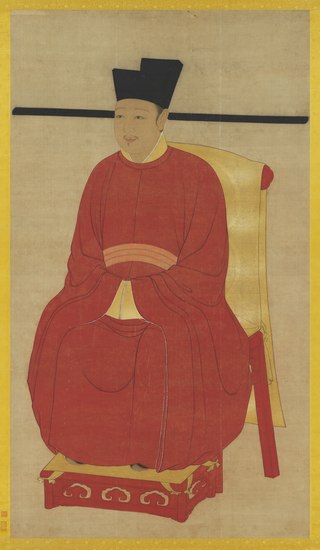
Emperor Huizong of Song, personal name Zhao Ji, was the eighth emperor of the Song dynasty of China and the penultimate emperor of the Northern Song dynasty. He was also a very well-known painter, poet and calligrapher. Born as the 11th son of Emperor Shenzong, he ascended the throne in 1100 upon the death of his elder brother and predecessor, Emperor Zhezong, because Emperor Zhezong's only son died prematurely. He lived in luxury, sophistication and art in the first half of his life. In 1126, when the Jurchen-led Jin dynasty invaded the Song dynasty during the Jin–Song Wars, Emperor Huizong abdicated and passed on his throne to his eldest son, Zhao Huan while Huizong assumed the honorary title of Taishang Huang. The following year, the Song capital, Bianjing, was conquered by Jin forces in an event historically known as the Jingkang Incident. Emperor Huizong and Emperor Qinzong and the rest of their family were taken captive by the Jurchens and brought back to the Jin capital, Huining Prefecture in 1128. The Emperor Taizong of Jin, gave the former Emperor Huizong a title, Duke Hunde, to humiliate him. After Zhao Gou, the only surviving son of Huizong to avoid capture by the Jin, declared himself as the dynasty's tenth emperor as Emperor Gaozong, the Jurchens used Huizong, Qinzong, and other imperial family members to put pressure on Gaozong and his court to surrender. Emperor Huizong died in Wuguocheng after spending about nine years in captivity. He, along with his successors, were blamed for the Song dynasty's decline.

Khanbaliq or Dadu of Yuan was the winter capital of the Yuan dynasty of China in what is now Beijing, the capital of China today. It was located at the center of modern Beijing. The Secretariat directly administered the Central Region of the Yuan dynasty and dictated policies for the other provinces. As emperors of the Yuan dynasty, Kublai Khan and his successors also claimed supremacy over the entire Mongol Empire following the death of Möngke in 1259. Over time the unified empire gradually fragmented into a number of khanates.
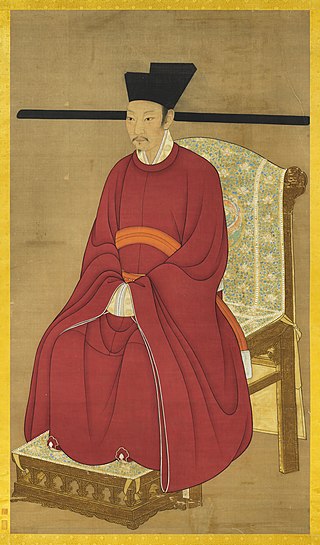
Emperor Qinzong of Song, personal name Zhao Huan, was the ninth emperor of the Song dynasty of China and the last emperor of the Northern Song dynasty.
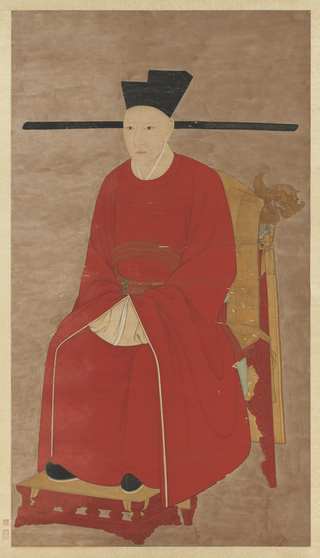
Emperor Gaozong of Song, personal name Zhao Gou, courtesy name Deji, was the tenth emperor of the Chinese Song dynasty and the first of the Southern Song dynasty, ruling between 1127 and 1162 and retaining power as retired emperor from 1162 until his death in 1187. The ninth son of Emperor Huizong and a younger half-brother of Emperor Qinzong, Zhao Gou was not present in the capital of Bianjing when it fell to the Jurchen-led Jin dynasty in 1127 during the beginning of the Jin-Song Wars. Narrowly avoiding capture by Jin forces, he escaped first to Yangzhou and then Lin'an, assuming the throne and reestablishing the Song court. Despite initial setbacks, including Jin invasions and a brief deposition in 1129, Emperor Gaozong consolidated his political position and presided over the continued military conflict with Jin. Prior to 1141, military commanders including Han Shizhong and Yue Fei reconquered portions of the Central Plains while chancellors like Lü Yihao, Zhao Ding, Zhang Jun, and Qin Hui managed the civil bureaucracy.

Emperor Taizu of Jin, personal name Aguda, sinicised name Min, was the founder and first emperor of the Jurchen-led Jin dynasty of China. He was originally the chieftain of the Wanyan tribe, the most dominant among the Jurchen tribes which were subjects of the Khitan-led Liao dynasty. Starting in 1114, Aguda united the Jurchen tribes under his rule and rebelled against the Liao dynasty. A year later, he declared himself emperor and established the Jin dynasty. By the time of his death, the Jin dynasty had conquered most of the Liao dynasty's territories and emerged as a major power in northern China. In 1145, he was posthumously honoured with the temple name Taizu by his descendant Emperor Xizong.
Jurchen language was the Tungusic language of the Jurchen people of eastern Manchuria, the rulers of the Jin dynasty in northern China of the 12th and 13th centuries. It is ancestral to the Manchu language. In 1635 Hong Taiji renamed the Jurchen ethnicity and language to "Manchu".

Acheng District is one of nine districts of the prefecture-level city of Harbin, the capital of Heilongjiang Province, Northeast China, covering part of the southeastern suburbs. The district was approved to establish from the former Acheng City (阿城市) by the Chinese State Council on August 15, 2006. As of 2010, it had a population of 596,856 residing in an area of 2,680 km2 (1,030 sq mi), and is 29 km (18 mi) southeast of downtown Harbin, 190 km (120 mi) north of Jilin City, and around 50 km (31 mi) south of the Songhua River. It lies within the basin of and until 1909 was considered synonymous with the Ashi River which gave its name to the Jurchen Jin Dynasty. The district administers nine subdistricts, eight towns, one township, and one ethnic township. It borders Daowai District to the north, Bin County to the northeast, Shangzhi to the southeast, and Wuchang to the south, Shuangcheng District to the west, and Pingfang and Xiangfang Districts to the northwest.

The Battle of Caishi was a major naval engagement of the Jin–Song Wars of China that took place on November 26–27, 1161. It ended with a decisive Song victory, aided by their use of gunpowder weapons.

The Jingkang Incident, also known as the Humiliation of Jingkang and the Disorders of the Jingkang Period, was an episode of invasions and atrocities that took place in 1127 during the Jin–Song Wars when the troops of the Jurchen-led Jin dynasty besieged and sacked the imperial palaces in Bianjing, the capital of the Han-led Northern Song dynasty. The Jin forces captured the Northern Song ruler, Emperor Qinzong, along with his father, the retired Emperor Huizong, and many members of the imperial family of Emperor Taizong's bloodline and officials of the Song imperial court. The ordinary Song civilians of Bianjing living in the non-imperial quarter were left alone after being forced to pay huge ransoms to the Jin.
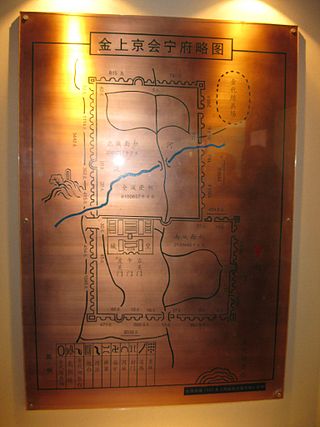
Huining Fu, or Shangjing Huiningfu, was a Fu in the Shangjing region of Northeast China. It served as the first superior capital of the Jurchen-led Jin dynasty (1115-1234) from 1122 to 1153. Its location was in present-day Acheng District, Harbin, Heilongjiang Province.

Nomadic empires, sometimes also called steppe empires, Central or Inner Asian empires, were the empires erected by the bow-wielding, horse-riding, nomadic people in the Eurasian Steppe, from classical antiquity (Scythia) to the early modern era (Dzungars). They are the most prominent example of non-sedentary polities.
The Song dynasty of China was an imperial dynasty that ruled most of China proper and southern China from the middle of the 10th century into the last quarter of the 13th century. The dynasty was established by Emperor Taizu of Song with his usurpation of the throne of Later Zhou, ending the Five Dynasties and Ten Kingdoms period.
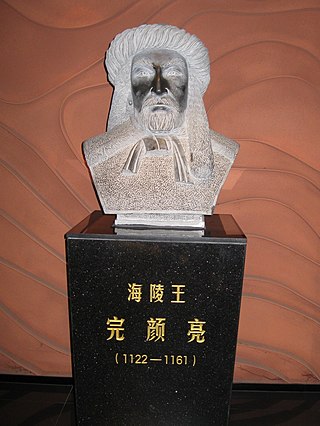
Digunai, also known by his sinicised name Wanyan Liang and his formal title Prince of Hailing, was the fourth emperor of the Jurchen-led Jin dynasty of China. He was the second son of Wanyan Zonggan, the eldest son of the dynastic founder Wanyan Aguda. He came to power in 1150 after overthrowing and murdering his predecessor, Emperor Xizong, in a coup d'état. During his reign, he moved the Jin capital from Shangjing to Yanjing, and introduced a policy of sinicisation. In 1161, after the Jin dynasty lost the Battle of Caishi against the Southern Song dynasty, Digunai's subordinates rebelled against him and assassinated him. After his death, even though he ruled as an emperor during his lifetime, he was posthumously demoted to the status of a prince – "Prince Yang of Hailing" (海陵煬王) – in 1162 by his successor, Emperor Shizong. However, in 1181, Emperor Shizong further posthumously demoted him to the status of a commoner, hence he is also known as the "Commoner of Hailing" (海陵庶人).
Nianhan (1080–1136), also known by his sinicised name Wanyan Zonghan, was a Jurchen noble and military general who lived in the founding and early years of the Jurchen-led Jin dynasty (1115-1234), which ruled northern China between the 12th and 13th centuries.

The Jin–Song Wars were a series of conflicts between the Jurchen-led Jin dynasty (1115–1234) and the Han-led Song dynasty (960–1279). In 1115, Jurchen tribes rebelled against their overlords, the Khitan-led Liao dynasty (916–1125), and declared the formation of the Jin. Allying with the Song against their common enemy the Liao dynasty, the Jin promised to cede to the Song the Sixteen Prefectures that had fallen under Liao control since 938. The Song agreed but the Jin's quick defeat of the Liao combined with Song military failures made the Jin reluctant to cede territory. After a series of negotiations that embittered both sides, the Jurchens attacked the Song in 1125, dispatching one army to Taiyuan and the other to Bianjing, the Song capital.

The Heilongjiang hand cannon or hand-gun is a bronze hand cannon manufactured no later than 1288 and is the world's oldest confirmed surviving firearm. It weighs 3.55 kg and is 34 centimeters long. The Heilongjiang hand cannon was excavated during the 1970s in Banlachengzi, a village in Acheng District, Heilongjiang province, China. It was found alongside other bronze artifacts made in the style of the Jurchen Jin Dynasty. The hand cannon was probably used in battles fought nearby in Banlachengzi in 1287 and 1288. The History of Yuan states that a Jurchen commander by the name of Li Ting led a group of soldiers equipped with hand cannons into a military camp in 1288, as part of an anti-rebellion campaign for the Yuan dynasty. The cannon currently resides at the Heilongjiang Provincial Museum in Harbin, China.
References
Citations
Bibliography
- "A-ch'eng", Encyclopædia Britannica, 15th ed. , Chicago: Encyclopædia Britannica, 2010, ISBN 978-1-59339-837-8 .
- Chan Hok-lam (2006), "What 'Manju' Was in the Beginning and When It Grew into a Place-name", Tumen Jalafun Jecen Akū: Manchu Studies in Honour of Giovanni Stary, Tunguso Sibirica, No. 20, Wiesbaden: Otto Harrassowitz GmbH, pp. 55–72, ISBN 9783447053785 .